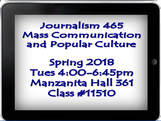Jour465 Mass Communication and Popular CultureStudy of the social, political and economic influences that shape popular culture and its effects on audiences. Examines media's role as storytellers across media platforms that deliver popular culture in the emergent global digital culture. Particular emphasis on applying critical thinking, research and writing skills to analyze media policies and practices and on developing strategies that empower consumers of popular culture in the media marketplace.
Students will apply media literacy skills and strategies to examine the dynamics of American popular culture across generations and to analyze the tipping point of cultural icons, artifacts, innovations and trends. Topics focus on entertainment, fashion, language, health, sports, leisure, work, family, politics, social media and other pop culture phenomena. |
Learning ObjectivesOverall Learning Goal: Students will become digital and media literate consumers and creators of popular culture with the ability to think critically about the role it plays in their personal lives, American society, and the global world in which they live.
|
